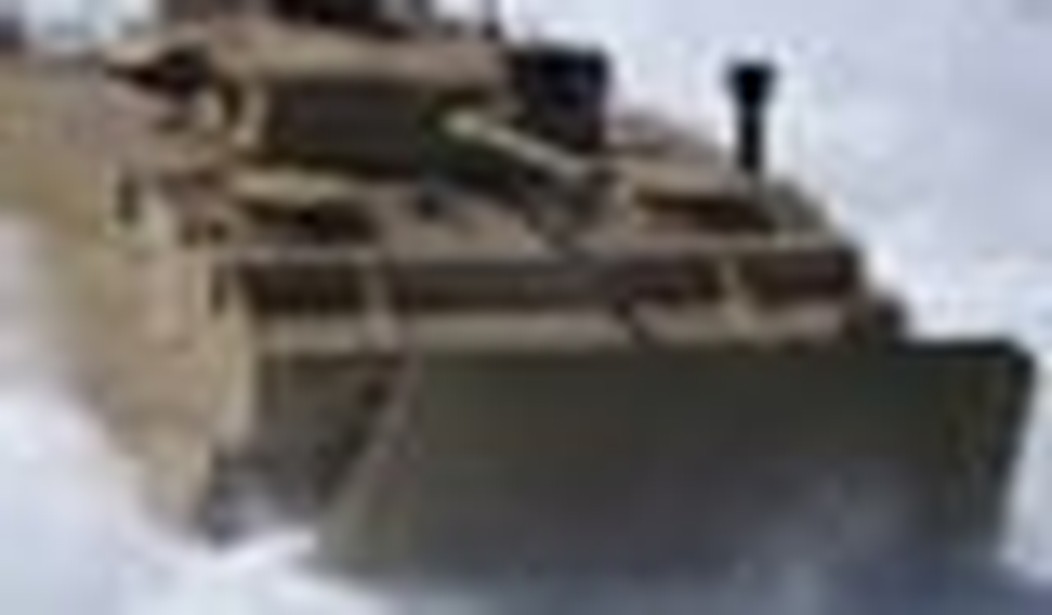Defense Secretary Robert Gates has signaled that the long-awaited and seriously over-budget Expeditionary Fighting Vehicle (EFV) may be the next high-profile project scrapped — the latest in a series of moves meant to streamline the Pentagon’s budget and refocus the military on future challenges.
The EFV, an amphibious armored troop transport, was designed to replace the tired AAV-7A1, a 1970s-era vehicle that has had its service life extended several times as the Marine Corps has sought a replacement.
Both vehicles occupy a specific niche that few vehicles in the world can (or try) to match. They are purpose-designed to transport Marines from the well deck of amphibious assault ships — “swimming” out the back of these massive carrier-like ships and carrying Marines ashore to conduct assaults on defended beaches. Once ashore, the Marine infantry pile out the back of the vehicles to conduct ground operations, while the armored amphibians use their tracks to crawl off the beach and provide close-in and mid-range fire support for the infantry through turret-mounted weapons systems. After the amphibious landing is over and the beach is secured, these tracked vehicles are used much as traditional armored personnel carriers and infantry fighting vehicles.
On paper, replacing the AAV-7A1 with a modernized amphibious troop carrier seems a no-brainer. Such vehicles are closely tied to the image the world developed of Marines in World War II, which saw the use of armored tractors called LVTs. Used from Tarawa onward, the use of amphibious armor became an integral part of Marine Corps doctrine.
But does a doctrine last employed in 1950 still have relevance in today’s world, against current and future enemies, and the expanded use of “smart” weapons systems? Are the millions being invested in the continued development of the EFV being spent to create a vehicle that will best serve current and future Marines?
The theory behind the EFV is that the high-speed planing performance of the craft would enable it to launch amphibious invasions from “over the horizon” — 25 miles out to sea, beyond the range of shore guns and line-of-sight shore-launched missiles that could target the multi-billion dollar amphibious assault ships (and other costly vessels of our modernized, smaller Navy). But the “over the horizon” doctrine that was the rationale behind the EFVs costly and problematic amphibious systems was envisioned during the 1980s. Evolving threats 30 years later include guided artillery and fire-and-forget missile systems that make the EFVs potential sitting ducks long before they ever hit the beach — turning them into seagoing coffins.
Likewise, the evolving threats posed by ship- and shore-launched cruise missiles mean that the 25 miles envisioned for “over the horizon” operations is no longer valid. Naval vessels can now be struck out to 100 miles or more — far beyond the swimming range of the EFV.
It seems clear to many that the doctrine of amphibious invasion on contested shores, refined and perfected during the bloody campaigns in the Pacific islands, may now be as obsolete as cavalry charges. Advances in defensive weaponry available to our possible adversaries (including non-state actors, as Hezbollah’s strike on the Israeli corvette Hanit proves) have rendered surface assaults from the sea obsolete, as well as surface-swimming amphibious armored vehicles.
If the doctrine of sea-based amphibious operations is now obsolete, what need is there for an armored amphibian for the Marines? Wouldn’t the Marines be best served by an armored vehicle that meets the threats of the 21st century, not hypothetical threats concocted in the last?
If the basic design of the EFV was something that could be salvaged, it might warrant another look, but even the basic design fails against the most common weapons of our current and future adversaries. The flat-bottomed hull that enables the EFV to skim over the waves makes the EFV especially vulnerable to the number-one killer of Marines and soldiers in our two current wars: IEDs and mines. While the Marines claim that the bolt-on kits give the EFV armor comparable to MRAPs, the armor only protects the sides of the vehicle. IEDs and mines are most deadly where they typically detonate under the vehicle, where the flat bottom of the EFV does nothing to dissipate the blast. It is, in short, a Marine killer.
Only institutional inertia and a sense of identity keep the Marines pushing ahead with the EFV. Simple, dispassionate logic dictates scrapping the EFV and starting the search for an alternative from the perspective of a combat-hardened 2010 Marine Corps.
Luckily for today’s Marines, there are options at hand.
A demonstrator version of a medium-armored personal carrier cleverly called the Marine Personnel Carrier (MPC) is already in development. Meant to compliment the more heavily armed and larger EFV, it nonetheless could perform many of the more common land warfare roles that the EFV might typically face in today’s asymmetrical conflicts and projected asymmetrical threat environments. The MPC concept is similar to the Stryker, another wheeled armored vehicle in the U.S. arsenal already used by the U.S. Army. The upgraded Stryker (LAV-H) might meet Marine needs. The Marines currently use the Stryker’s older “cousin” in the LAV-25 family of vehicles to provide fire support, counter-battery fire, and scouting capabilities.
The hardest part of killing the EFV program for the Marine Corps won’t be the physical shift to a different kind of vehicle and the doctrine to best employ it. It would be the crisis of identity that could result from altering the amphibious assault persona that has been a part of the Corps for almost 70 years. The next generation of Marines may not hit the beach in a modernized version of their great-grandfathers’ LVT, but instead in high-speed, heavily networked vehicles brought ashore by high speed hovercraft. Perhaps even a futuristic submersible APC that gives defenders almost no warning at all before crawling out of the ocean with railguns blazing.
Whatever the future holds for the Marine Corps, the Expeditionary Fighting Vehicle shouldn’t be part of it, and our Marines are well-served by a secretary of defense willing to overrule generals still trying to fight the last war. Some will focus on Gates’ desire to pare military spending, which in and of itself is an admirable goal. Looking at the systems, however, it seems far more likely that Gates is trying to preserve a far more valuable treasure: the lives of our Marines.









Join the conversation as a VIP Member